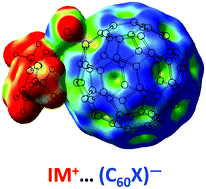Imidazolium–fulleride ionic liquids – a DFT prediction†
Abstract
Ionic liquids (ILs) exhibit tunable physicochemical properties due to the flexibility of being able to select their cation–anion combination from a large pool of ions. The size of the ions controls the properties of the ILs in the range from ionic to molecular, and thus large ions play an important role in regulating the melting temperature and viscosity. Here, we show that the exohedral addition of anionic X− moieties to C60 (X = H, F, OH, CN, NH2, and NO2) is a thermodynamically viable process for creating large X-fulleride anions (C60X)−. The addition of X− to C60 is modelled by locating the transition state for the reaction between C60 and 1,3-dimethyl-2X-imidazole (IMX) at the M06L/6-311++G(d,p)//M06L/6-31G(d,p) level. The reaction yields the ion-pair complex IM+⋯(C60X)− for X = H, F, OH, CN, NH2, and NO2 and the ordered pair of (activation free energy, reaction free energy) is found to be (14.5, 1.1), (6.1, 3.1), (16.7, 2.3), (14.7, −7.9), (27.9, 0.5) and (11.9, 12.4), respectively. The low barrier of the reactions suggests their feasibility. The reaction is slightly endergonic for X = H, F, OH, and NH2, while X = CN shows a significant exergonic character. The X-fulleride formation is not observed when X = Cl and Br. The ion-pair interactions (Eion-pair) observed for IM+⋯(C60X)− range from −64.0 to −73.0 kcal mol−1, which is substantially lower (∼10%) than the typically reported values for imidazolium-based ionic liquids such as [EMIm]+[trz]−, [EMIm]+[dc]−, [EMIm]+[dtrz]−, and [EMIm]+[NH2tz]−. The quantum theory of atoms in molecules (QTAIM) analysis showed that the C–X bonding in (C60X)− is covalent, while that in (IM+⋯X−)⋯C60 (for X = Cl and Br) is non-covalent. Furthermore, molecular electrostatic potential (MESP) analysis showed that the X-fulleride could behave as a large spherical anion due to the delocalization of the excess electron in the system over the entire carbon framework. The large anionic character of the X-fulleride is also revealed by the identification of several close lying local energy minima for the IM+⋯(C60X)− ion-pair. The low Eion-pair value, the significant contribution of dispersion to the Eion-pair and the spherical nature of the anion predict low-melting point and highly viscous IL formation from X-fullerides and the imidazolium cation.

- This article is part of the themed collection: 2021 PCCP HOT Articles


 Please wait while we load your content...
Please wait while we load your content...